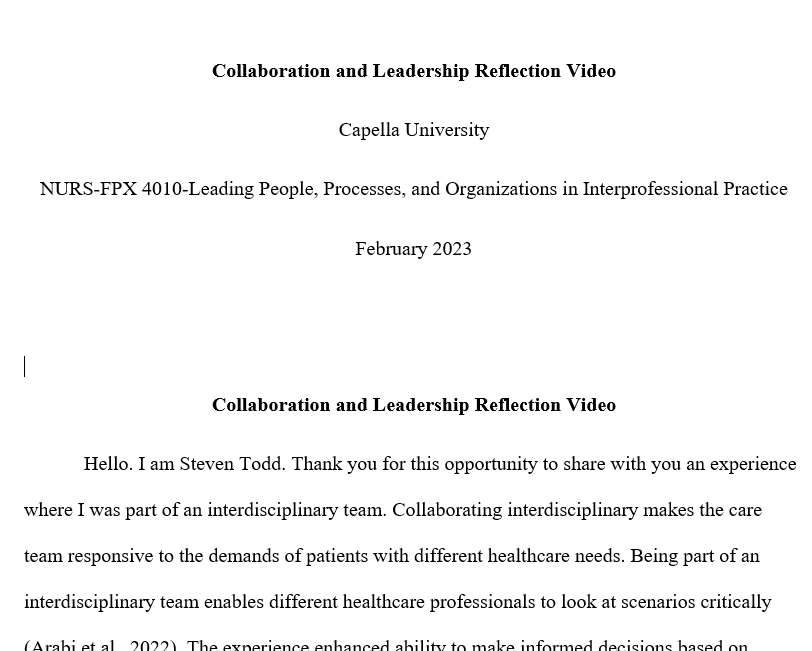NURS-FPX4010_Ts_Assessment 1-1 Solution.docx
Collaboration and Leadership Reflection Video
Capella University
NURS-FPX 4010-Leading People, Processes, and Organizations in Interprofessional Practice
February 2023
Collaboration and Leadership Reflection Video
Hello. I am Steven Todd. Thank you for this opportunity to share with you an experience where I was part of an interdisciplinary team. Collaborating interdisciplinary makes the care team responsive to the demands of patients with different healthcare needs. Being part of an interdisciplinary team enables different healthcare professionals to look at scenarios critically (Arabi et al., 2022).
The experience enhanced ability to make informed decisions based on awareness about gaps and improvements necessary to optimize care outcomes. I was part of an interdisciplinary team responsible for investigating an incident involving patient fall and resulting injuries. An elderly patient within the medical-surgical unit fell leading to a fractured knee.
The issue triggered the nurse manager to initiate an inquiry into the lapses within the clinical environment and improvements necessary to prevent similar incidents in the future. The nurse manager assembled a team of physicians, nurses, and clinical assistants.
I was tasked with the role of engaging patients and seeking feedback about near falls and lapses likely to trigger falls and injuries. The experience allowed me to collaborate with patients, physicians, nurses, and clinical assistants in discussing lapses within the clinical environment and evidence-based practices for preventing patient falls and injuries. Vulnerability of patients in the medical-surgical unit to falls reinforced the need for shared governance and decision-making.
One success of an interdisciplinary process is excellent communication (Heath & Porter, 2020). We maintained positive interpersonal relations characterized by the willingness to help each other synthesize accurate and adequate evidence on lapses likely to cause patient falls. Similarly, clarity of roles enabled everyone to stick to the scope of practice and produce conclusive findings about the causes, consequences, and measures for preventing patient falls and injuries.
Clarity of roles explains the ability of the team members to gather evidence from different sources and make informed conclusions about the risk of patient falls and injuries. The interdisciplinary collaboration provided lessons on the need for nurses, physicians, clinical assistants, and others to portray positive behaviors, attitudes, and beliefs across the continuum.
This way, healthcare professionals should appreciate calls for shared decision-making to encourage everyone to share their views and experiences (Heath & Porter, 2020). The freedom to share knowledge and interactive sessions enabled the team to produce a conclusive report detailing risks associated with patient falls, implications, and sustainable measures to enhance safety and quality of patient care.
Improving Interdisciplinary Collaboration
Interdisciplinary collaboration works well where leaders interact with followers to understand their position about a proposed change. The right leaders create an environment that supports proactive interpersonal relations. Everyone is willing to share ideas, skills, knowledge, and experiences on issues facing the hospital and interventions needed to optimize care outcomes.
Hussain et al. (2018) acknowledged the need for health leaders to embrace transformational approaches based a people-centered framework. The leader involves the care team and relevant parties in the change process for an informed conclusion about viability of the proposed technology. The situation at Clarion Court Skilled Nursing Facility reveals leadership gaps, power distances, and hierarchical barriers that undermined efforts to create and sustain a collaborative clinical environment.
The leaders did not understand the staff and denied the IT team, registered nurses, and others the chance to share insights into viability of the proposed change. Leadership changes are necessary to inspire a shared vision and promote collective buy-in when planning for a change (Arabi et al., 2022).
The transformational leader is vital for the facility to communicate a common goal and make everyone responsive to strategic priorities. The leader listens, mentors, and empowers the care team to share suggestions about new processes, procedures, and systems designed to enhance the quality and safety of patient care (Nilsen et al., 2020).
Another strategy appropriate for Clarion Court Skilled Nursing Facility is shared governance that allows nurses, physicians, pharmacists, the IT team, and non-clinical workers to play active roles in decision-making.
The process reminds everyone about their frontline roles at the bedside and organizational levels. The team initiate mutual conversations with leaders acknowledging their roles in creating a conducive environment for collaborative discussions before implementing a new technology.
In conclusion, ineffective upstream communication processes are among the barriers that undermine successful implementation of a change. The issue reveals the need for hospitals to have transformational leaders who value team efforts, motivate individuals, and allow everyone to share suggestions about the pathways for implementing changes.
The right leaders understand the workforce and utilize interdisciplinary collaboration to streamline communication and maintain an enthusiastic clinical environment.
References
Arabi, Y., Al Ghamdi, A., Al-Moamary, M., Al Mutrafy, A., Al Hazme, R., & Al Knawy, B. (2022). Electronic medical record implementation in a large healthcare system from a leadership perspective. BMC Medical Informatics and Decision Making, 22(66), 1-9. https://www.ncbi.nlm.nih.gov/pmc/articles/PMC8922058/pdf/12911_2022_Article_1801.pdf
Heath, M., & Porter, T. (2020). Change management overlooked: Physician perspectives on EHR implementation. American Journal of Business, 34(4), 19-35. https://ideas.repec.org/a/eme/ajbpps/ajb-09-2017-0028.html
Hussain, S. T., Lei, S., Akram, T., Haider, M. J., Hussain, S. H., & Ali, M. (2018). Kurt Lewin’s change model: A critical review of the role of leadership and employee involvement in organizational change. Journal of Innovation and Knowledge, 3(3), 123-127. https://www.sciencedirect.com/science/article/pii/S2444569X16300087
Nilsen, P., Seing, I., Ericsson, C., Birken, S., & Schildmeijer, K. (2020). Characteristics of successful changes in health care organizations: An interview study with physicians, registered nurses and assistant nurses. BMC Health Services Research, 20(147), 1-8. https://bmchealthservres.biomedcentral.com/articles/10.1186/s12913-020-4999-8



